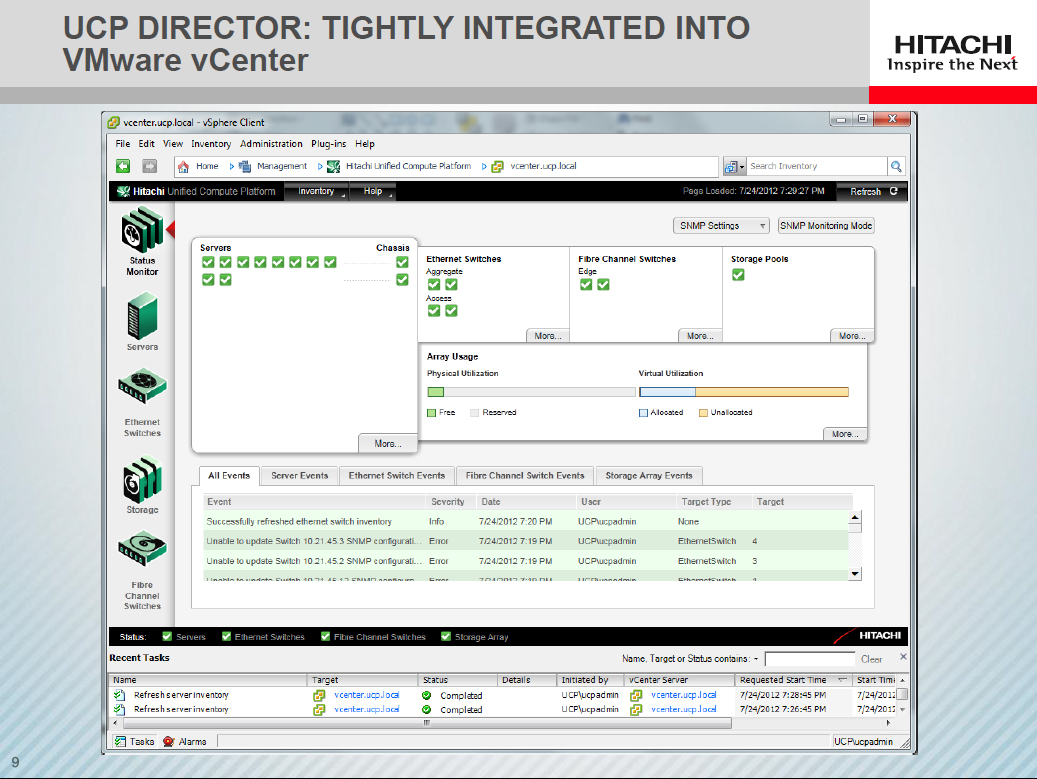Storage vendor Hitachi Data Systems announced today that it is selling a prebuilt infrastructure and a pretested reference architecture that combine servers, networks, storage and management components that can be deployed in days.
HDS's new Unified Compute Platform (UCP) follows the lead of bundled offerings from NetApp, Hewlett-Packard, Dell and EMC, through its Virtual Computing Environment (VCE) joint venture with Cisco Systems.
"This market has been served by either solution providers, [whose offerings include] all components from the same vendor, or by preconfigured and pretested packages comprised of best-of-breed components from different vendors," Ashish Nadkarni, a storage analyst at research firm IDC, said in a statement. "HDS is breaking this either/or mold by combining the best of each approach."
Along with using its own storage arrays, HDS has struck a partnership deal with Cisco to use its Unified Computing System (UCS) blade servers and switches.
Because HDS is a wholly-owned subsidiary of system vendor Hitachi Ltd., it is also offering a choice of servers and hypervisors. For example, users can choose the Cisco UCS or Hitachi's CB2000, CB500 or CR200 servers. HDS is also offering a choice of Cisco or Brocade Fibre Channel or Ethernet switches.
HDS's UCP comes in two flavors: The Hitachi UCP Pro, which is a prebuilt turnkey system that can be installed in two days, and the Hitachi UCP Select, which offers users a series of pre-validated reference architectures that are pretested by HDS but built and installed by the customer with Hitachi's help.
As expected, on the storage front, HDS is offering a choice of its high-end Virtual Storage Platform (VSP) or its midrange Hitachi Unified Storage (HUS) arrays, which offer both file and block-level data storage options. The HUS 150 has a maximum capacity of 3 petabytes with up to 960 drives. The HUS 130 can hold up to 756TB.
Hitachi's UCP bundles can be configured for to nine specific application environments. For example, bundles can be configured to support a Microsoft Exchange 2010 environment with 90,000 email boxes, a Citrix Xen Desktop virtual desktop infrastructure, or a business analytics system using SAP HANA. Each bundle is tested and certified by the application provider.
HDS's UCP bundle can be configured for a number of hypervisors, including Citrix Xen Desktop, Microsoft HyperV or VMware.
EMC was the first company to begin offering bundled storage, server and networking solutions. Its vBlock architecture is a combination of products brought together through its VCE partnership with Cisco and VMware, a subsidiary of EMC. NetApp followed suit with its FlexPod offering; like EMC, NetApp signed a deal with Cisco for its UCS platform. Other options from big vendors include Hewlett-Packard's VirtualSystem and Dell's vStart bundles.
In addition to the established storage and systems vendors, a number of startups are creating preconfigured systems. Examples include SimpliVity's OmniCube, Scale Computing's HC3 and Nutanix's Complete Cluster.
Ravi Chalaka, HDS's vice president of solutions marketing, said HDS's new UCP offering will save users time and money, not by reducing the cost of materials, necessarily, but by cutting down on the time it takes to purchase, configure and test an architecture.
"It can take as long as 18 to 24 months to bring one online, and that's a lot of energy and cost that IT organizations would like to avoid," he said.
Along with the hardware and hypervisors, the new converged architecture comes with UCP Director, a VMware vCenter integrated management console, which offers a single view of both physical and virtual environments.

UCP Director, a console tightly integrated with VMware's vCenter.
UCP Director allows administrators to provision server, network or storage capacity using RESTful APIs. It also offers real-time monitoring and troubleshooting capabilities.
"Now storage admins can focus on other jobs, such as storage planning or setting up disaster recovery protection," Chalaka said.





